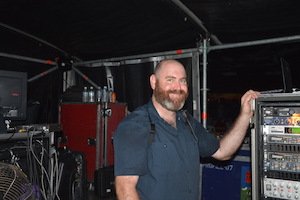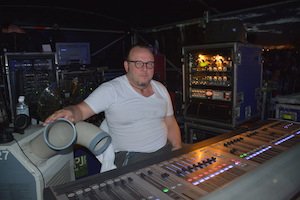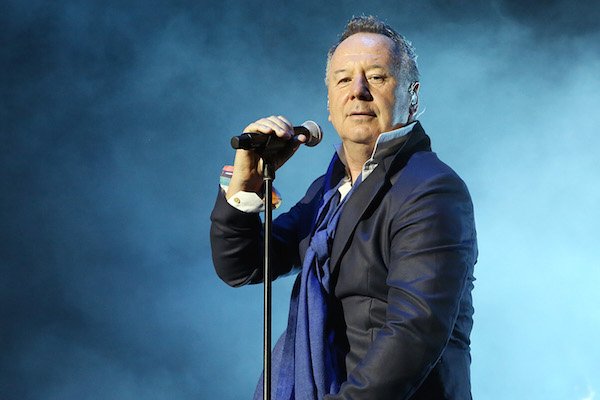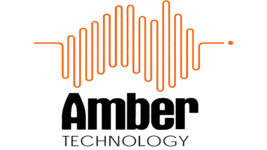News
12 Apr 2017
What happens to the tech when the gig is TOO HOT!

Subscribe to CX E-News
By Cat Strom
As the temperature hit 46°C, organisers struggled to keep the punters cool. A large shade area was erected, as well as a rather small misting tent, and a water truck dumped water on the crowds at the back. There was free drinking water but by the time it travelled through metal pipes, it too was hot. Cooling scarves were available for $10. Not surprisingly, the queues for alcohol were the smallest I’ve ever seen.
While there were safety concerns for the punters, spare a thought for the crew who did not have the option whether to attend or not.
“It was a very stressful day and once you get past 39°C, you cannot cope without a proper cooling system,” said Olivier Gerard, FOH engineer for Simple Minds (pictured). “As you know, all of the digital gear and computers are all based on hard drives and hard drives cannot cope with such heat.”
 The decision was made to line-check early in the day and then all equipment FOH was completely shut down, which was a bit of a gamble. Luckily Olivier had a cooling system for himself and his gear during the show, having experienced gear failure on a previous hot Australian tour.
The decision was made to line-check early in the day and then all equipment FOH was completely shut down, which was a bit of a gamble. Luckily Olivier had a cooling system for himself and his gear during the show, having experienced gear failure on a previous hot Australian tour.
“Unfortunately with the Soundcraft Vi series, especially the older models, the cooling system was not that great. In my own Vi I have installed a customized cooling system into the console which takes over when there are temperature problems. Of course, at 40°C+ nothing is going to help. The computers were a problem but by the time Simple Minds took to the stage the temperature had dropped to about 36°C which was manageable.”
The B52’s, who played before Simple Minds, had quite a few computer problems and lost all of their keyboard sounds. Simple Minds use the same technology for their keyboards and they were worried that they would lose their keyboards too.
“We have a very good keyboard tech who kept all of the keyboards inside the air conditioned dressing room, only bringing them out at the last minute,” commented Olivier. “Basically we kept all we could in air conditioning or switched it off until the last moment which is risky. Usually in our work if you turn something on and it works, you leave it on as switching gear on and off can cause problems. It was the only way we could do it and fortunately it all worked out well.”
As Simple Minds travelled the country they used a variety of PA systems supplied by JPJ Audio, an L-Acoustics K1 system was supplied to Bimbadgen, which did not concern Olivier at all.
 “If you have a good PA tech, they can make any system sound how you want it to, and JPJ’s Josh De Jong (pictured applying cooling to the FOH console) was very good, making my job easier,” he added. “Some PA systems are easier for me to work with because I feel them more, but any of the good systems will work.”
“If you have a good PA tech, they can make any system sound how you want it to, and JPJ’s Josh De Jong (pictured applying cooling to the FOH console) was very good, making my job easier,” he added. “Some PA systems are easier for me to work with because I feel them more, but any of the good systems will work.”
Olivier describes mixing for Simple Minds as a challenge due to the fact that they cover such a long period of time and thus a variety of musical styles and dedicated sound.
“The eighties sound was very particular whereas the nineties sound was more rock,” he said. “Then they got more pop before going back to rock and then electronic. Obviously their biggest hits were from the late eighties and I think it’s very important that when a fan hears one of those songs, they should instantly be brought back to that time. We worked a lot on those sounds so that you can recognize the song on the first note.”
Olivier focuses a lot on bringing the energy of the band over to the people. This is a band that know how to perform and entertain but it’s not all easy.
“Jim has a microphone technique of his own and you have to work hard to keep the vocal above the loud and very intense music, he remarked. “I like to bring my own microphones on tour because when everything is programmed in the desk, it’s important to have the source right.”
Olivier travels with his own set of microphones particularly as the band has an endorsement for the drum mics with BeyerDynamic. The vocals are taken care of by Shure Beta 58’s, with the backup singers using DPA d:facto mics. There’s a Beyer M88 on the bass, and a Neumann KM 140 on drum overheads for the cymbals.
FOH Olivier was running a Soundcraft Vi6 console, although he usually uses a Vi4, saying he prefers the size and footprint of it. Outboard effects are used for the vocal and the bass, with drum treatments and a compressor on the main mix.
“The band are all on IEMs except for guitarist Charlie who prefers wedges,” said Olivier. “It’s quite common for guitar players to not use IEMs, because guitar playing is not only what you hear but what you feel, controlling the feedback is more a physical thing – you feel the strengths oscillating under your hands and if you don’t use any wedges or amps, you can’t control it properly.
Subscribe
Published monthly since 1991, our famous AV industry magazine is free for download or pay for print. Subscribers also receive CX News, our free weekly email with the latest industry news and jobs.







